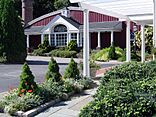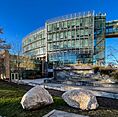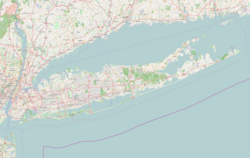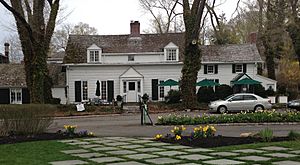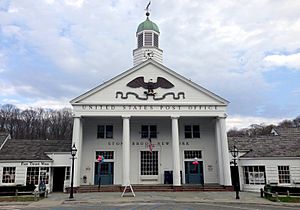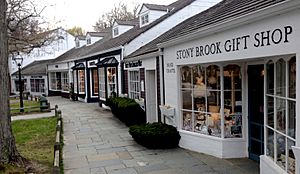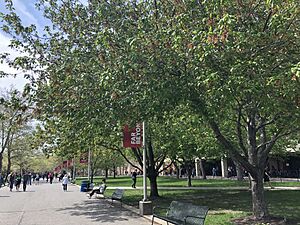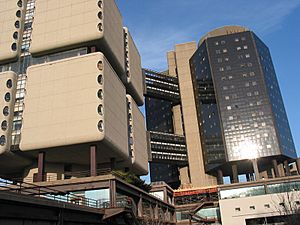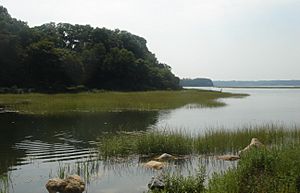Stony Brook, New York facts for kids
Quick facts for kids
Stony Brook, New York
Wopowog
|
|
|---|---|
|
Stony Brook University
Simons Center for Geometry and Physics
Stony Brook Harbor
Stony Brook Hospital
|
|
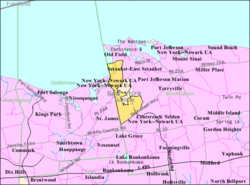
U.S. Census map
|
|
| Country | |
| State | |
| County | Suffolk |
| Town | Brookhaven |
| Area | |
| • Total | 6.25 sq mi (16.18 km2) |
| • Land | 5.82 sq mi (15.08 km2) |
| • Water | 0.42 sq mi (1.10 km2) |
| Elevation | 89 ft (27 m) |
| Population
(2020)
|
|
| • Total | 13,467 |
| • Density | 2,312.73/sq mi (892.91/km2) |
| Time zone | UTC−5 (Eastern (EST)) |
| • Summer (DST) | UTC−4 (EDT) |
| ZIP Codes |
11790, 11794
|
| Area codes | 631, 934 |
| FIPS code | 36-71608 |
| GNIS feature ID | 0966524 |
Stony Brook is a community in Suffolk County, New York, located on the North Shore of Long Island. It's known as a hamlet, which is a small town, and also a census-designated place (CDP). This means it's a recognized area for counting people, but it's not officially a village or city by the state.
Stony Brook started as a farming area in the past. Over time, it grew into a popular resort town and now is a major spot for tourists and a center for learning. It is home to Stony Brook University, which is one of the biggest public universities in New York. You can also find The Stony Brook School, a private school, and the Long Island Museum of American Art, History, and Carriages here. The Stony Brook Village Center is a special shopping area designed to look like an old New England town.
Contents
History of Stony Brook
Early Beginnings
Stony Brook was first settled in the late 1600s. The area was originally called Wopowog by the native people. Both "Wopowog" and "Stony Brook" likely refer to the connected waterways nearby. It began as a smaller community next to Setauket, New York, which was the first settlement in the Town of Brookhaven. The land was bought from the native Setalcott tribe in 1655.
A gristmill was built in 1699 on what is now called the Mill Pond. This mill ground grain into flour. The building you see today was built in 1751. It stopped grinding grain in the 1940s and is now open for public tours. For a long time, people in Stony Brook had to go to nearby Setauket or St. James for church and school. Later in the 1700s, more activity moved north toward the harbor, and new homes were built there.
Stony Brook was quite remote in the 1700s. There was some trade near the mill, but the harbor was hard to reach compared to nearby Setauket and Port Jefferson. In the 1840s, a local painter named William Sidney Mount tried to get the harbor deepened, but it kept filling up with sand. So, Stony Brook focused on farming and selling wood instead of harbor trade.
Growth and Development
The Long Island Rail Road arrived in Stony Brook in the 1870s. This made it easy for people from New York City to visit. Stony Brook quickly became a popular summer spot for city dwellers looking to escape city life. The Stony Brook Assembly, started in 1909, also brought more people to the area. Many visitors built houses and cottages, some of which are now used all year round.
Most businesses were located in a small area that is now the village green. These shops were practical and not very organized. The history of Stony Brook is closely tied to Ward Melville, a local businessman. He owned a lot of land in the "Three Village" area, which includes Stony Brook, Setauket, and Old Field.
Starting in 1939, Melville used his money to transform part of Stony Brook into his vision of a perfect New England village. This became the Stony Brook Village Center, with white buildings and charming shops. He moved many existing shops into a crescent shape around a village green. He also built the Stony Brook Post Office, which has a large eagle on top that flaps its wings every hour.
Modern Stony Brook
Ward Melville also gave land and money to New York State to build a branch of the State University of New York here. This led to the creation of Stony Brook University, which moved from Oyster Bay to Stony Brook. Melville also helped the local school district. The Three Village Central School District serves several communities, and its main high school, Ward Melville High School, is named after him.
Today, popular places to visit include the Stony Brook Grist Mill and the Long Island Museum of American Art, History, and Carriages. You can also see the 19th-century William Sidney Mount House, the St. James Episcopal Chapel, and the West Meadow Beach Historic District.
Geography and Location
Stony Brook is located on the North Shore of Long Island. It's about 55 miles (89 km) east of Manhattan, which is part of New York City. The area is shaped a bit unevenly, stretching about 5 miles (8 km) from north to south and 1 mile (1.6 km) from east to west.
The oldest part of Stony Brook grew around the Stony Brook Harbor, which is a narrow inlet from the Long Island Sound. This area includes the Stony Brook Village Center, a shopping area that opened in 1941. Nearby are the Long Island Museum, the Three Village Inn, and the William Sidney Mount House. A piece of land called West Meadow has a beach and a nature reserve with wetlands.
Stony Brook University is located within and next to the community. Its main campus is less than 2 miles (3.2 km) from the historic center of Stony Brook. The university is mostly on the eastern side of the area. You can enter the campus from Route 25a near the Stony Brook train station. Route 25A also has many shops and businesses that serve the university students.
The southern part of Stony Brook, further inland, mostly has homes built after World War II. The Stony Brook University Research and Development Park is between this area and the university campus. The southern border of Stony Brook is Route 347. This road has many businesses, including a movie theater within Stony Brook, and the Smith Haven Mall nearby.
Education in Stony Brook
Stony Brook is well known for its schools. It is home to The Stony Brook School, a private preparatory school, and Stony Brook University.
Most of the community is served by the Three Village Central School District. However, a small part in the southwest is served by the Middle Country Central School District. So, children living in Stony Brook go to public schools in one of these two districts, depending on where they live.
Transportation
The Stony Brook train station is located in the community and serves its residents. It's part of the Long Island Rail Road's Port Jefferson Branch. A train ride to Penn Station in New York City takes about 1 hour and 48 minutes. This usually includes a transfer at stations like Huntington, Hicksville, or Jamaica.
Population and People
| Historical population | |||
|---|---|---|---|
| Census | Pop. | %± | |
| 2020 | 13,467 | — | |
| U.S. Decennial Census | |||
In 2010, there were about 13,727 people living in Stony Brook. There were 4,758 households and 3,787 families. The population density was about 2,390 people per square mile.
Most people in Stony Brook are White (88.6%). About 7.5% are Asian, and 1.7% are African American. About 4.4% of the population is Hispanic or Latin.
About 39.2% of households had children under 18 living with them. Most households (71.3%) were married couples living together. The average household had 2.88 people.
The median age in Stony Brook was 39 years old. About 26.9% of the population was under 18, and 12.7% were 65 or older.
The median income for a household in Stony Brook was $90,009. For families, it was $95,567. Only a small percentage of families (1.9%) and people (2.9%) lived below the poverty line.
Local Media
- SBU TV, Stony Brook University Television
- Stony Brook Independent, a publication at Stony Brook University
- Stony Brook Press, a newspaper at Stony Brook University
- The Statesman, the oldest newspaper at Stony Brook University
- The Village Times Herald, a newspaper in Setauket
- WUSB (FM), Stony Brook University Radio at 90.1 FM
Notable People from Stony Brook
Many interesting people have lived in or are connected to Stony Brook:
- Bud Abbott (1897–1974), a famous comedian.
- Awkwafina, an actress and rapper.
- George Booth, a cartoonist for The New Yorker.
- Sarah Drew, an actress.
- Brooke Ellison, the first quadriplegic person to graduate from Harvard University.
- Kevin James, a comedian and actor.
- Anthony Kay, a pitcher for the Toronto Blue Jays baseball team.
- Steven Matz, a pitcher for the St. Louis Cardinals baseball team.
- Cliff Robertson, an actor.
- Jim Simons, a mathematician and successful investor.
- Louis Simpson, a poet who won a Pulitzer Prize.
- Gary Valentine, a comedian and actor.
- Koyo_(band), a music band.
See also
 In Spanish: Stony Brook para niños
In Spanish: Stony Brook para niños




